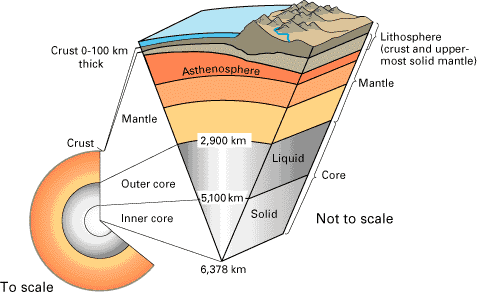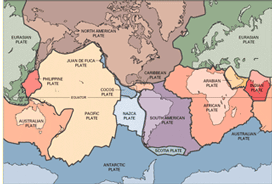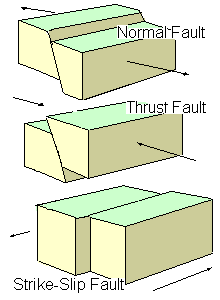|
|
Earthquakes,
Faults, Plate Tectonics, Earth Structure
|
Q:What is an earthquake and
what causes them to happen?
|
| A: An earthquake
is caused by a sudden slip on a fault. Stresses in the earth's
outer layer push the sides of the fault together. Stress builds
up and the rocks slips suddenly, releasing energy in waves
that travel through the earth's crust and cause the shaking
that we feel during an earthquake. An EQ occurs when plates
grind and scrape against each other. In California there are
two plates the Pacific Plate and the North American Plate.
The Pacific Plate consists of most of the Pacific Ocean floor
and the California Coast line. The North American Plate comprises
most the North American Continent and parts of the Atlantic
Ocean floor. These primary boundary between these two plates
is the San Andreas Fault. The San Andreas Fault is more than
650 miles long and extends to depths of at least 10 miles.
Many other smaller faults like the Hayward (Northern California)
and the San Jacinto (Southern California) branch from and
join the San Andreas Fault Zone. The Pacific Plate grinds
northwestward past the North American Plate at a rate of about
two inches per year. Parts of the San Andreas Fault system
adapt to this movement by constant "creep" resulting in many
tiny shocks and a few moderate earth tremors. In other areas
where creep is NOT constant, strain can build up for hundreds
of years, producing great EQs when it finally releases. For
further information, see the USGS General Interest Publication
"Earthquakes". |
Q: Can we
cause earthquakes? Is there any way to prevent earthquakes?
|
| A: Earthquakes
induced by human activity have been documented in a few locations
in the United States, Japan, and Canada. The cause was injection
of fluids into deep wells for waste disposal and secondary
recovery of oil, and the use of reservoirs for water supplies.
Most of these earthquakes were minor. The largest and most
widely known resulted from fluid injection at the Rocky Mountain
Arsenal near Denver, Colorado. In 1967, an earthquake of magnitude
5.5 followed a series of smaller earthquakes. Injection had
been discontinued at the site in the previous year once the
link between the fluid injection and the earlier series of
earthquakes was established. (Nicholson, Craig and Wesson,
R.L., 1990, Earthquake Hazard Associated with Deep Well Injection--A
Report to the U.S. Environmental Protection Agency: U.S. Geological
Survey Bulletin 1951, 74 p.) Other human activities, even
nuclear detonations, have not been linked to earthquake activity.
Energy from nuclear blasts dissipates quickly along the Earth's
surface. Earthquakes are part of a global tectonic process
that generally occurs well beyond the influence or control
of humans. The focus (point of origin) of earthquakes is typically
tens to hundreds of miles underground. The scale and force
necessary to produce earthquakes are well beyond our daily
lives. We cannot prevent earthquakes; however, we can significantly
mitigate their effects by identifying hazards, building safer
structures, and providing education on earthquake safety. |
Q: There have not been many earthquakes lately. Does that mean a big one is coming?
|
|
A: A temporary increase or decrease in the seismicity
rate is usually just part of the natural variation in the
seismicity. There is no way for us to know whether or not
this time it will lead to a larger earthquake. Swarms
of small events, especially in geothermal areas, are common,
and moderate-large magnitude earthquakes will typically
have an aftershock sequence that follows. All that is normal
and expected earthquake activity.
|
Q: What
do we know about the interior of the Earth?
|
|
A: 
Five billion years ago the Earth was
formed by a massive conglomeration of space materials. The
heat energy released by this event melted the entire planet,
and it is still cooling off today. Denser materials like
iron (Fe) sank into the core of the Earth, while lighter
silicates (Si), other oxygen (O) compounds, and water rose
near the surface. The earth is divided into four main layers:
the inner core, outer core, mantle, and crust. The core
is composed mostly of iron (Fe) and is so hot that the outer
core is molten, with about 10% sulfur (S). The inner core
is under such extreme pressure that it remains solid. Most
of the Earth's mass is in the mantle, which is composed
of iron (Fe), magnesium (Mg), aluminum (Al), silicon (Si),
and oxygen (O) silicate compounds. At over 1000 degrees
C, the mantle is solid but can deform slowly in a plastic
manner. The crust is much thinner than any of the other
layers, and is composed of the least dense calcium (Ca)
and sodium (Na) aluminum-silicate minerals. Being relatively
cold, the crust is rocky and brittle, so it can fracture
in earthquakes. (Univ. of Nevada)
This is a brief summary of our knowledge
of the earth's interior. For further information, see:
University
of Nevada
|
Q: What
is plate tectonics?
|
|
A: Plate
tectonics is the continual slow movement of the tectonic
plates, the outermost part of the earth. This motion is
what causes earthquakes and volcanoes and has created most
of the spectacular scenery around the world.
For further information, see:
This
Dynamic Earth: The Story of Plate Tectonics

Click on this image to see a larger version.
|
Q: What
is a fault and what are the different types?
|
|
A: A fault is a fracture or
zone of fractures between two blocks of rock. Faults allow
the blocks to move relative to each other. This movement
may occur rapidly, in the form of an earthquake - or may
occur slowly, in the form of creep. Faults may range in
length from a few millimeters to thousands of kilometers.
Most faults produce repeated displacements over geologic
time. During an earthquake, the rock on one side of the
fault suddenly slips with respect to the other. The fault
surface can be horizontal or vertical or some arbitrary
angle in between.
Earth scientists use the angle
of the fault with respect to the surface (known as the
dip) and the direction of slip along the fault to
classify faults. Faults which move along the direction of
the dip plane are dip-slip faults and described as either
normal or reverse, depending on their motion. Faults which
move horizontally are known as strike-slip faults and are
classified as either right-lateral or left-lateral. Faults
which show both dip-slip and strike-slip motion are known
as oblique-slip faults.
The following definitions are adapted
from The Earth by Press and Siever.
 normal
fault - a dip-slip fault in which the block above the
fault has moved downward relative to the block below. This
type of faulting occurs in response to extension and is
often observed in the Western United States Basin and Range
Province and along oceanic ridge systems. normal
fault - a dip-slip fault in which the block above the
fault has moved downward relative to the block below. This
type of faulting occurs in response to extension and is
often observed in the Western United States Basin and Range
Province and along oceanic ridge systems.
thrust fault - a dip-slip
fault in which the upper block, above the fault plane, moves
up and over the lower block. This type of faulting is common
in areas of compression, such as regions where one plate
is being subducted under another as in Japan. When the dip
angle is shallow, a reverse fault is often described as
a thrust fault.
strike-slip fault - a fault
on which the two blocks slide past one another. The San
Andreas Fault is an example of a right lateral fault.
A left-lateral strike-slip fault
is one on which the displacement of the far block is to
the left when viewed from either side.
A right-lateral strike-slip
fault is one on which the displacement of the far
block is to the right when viewed from either side.
(UC Berkeley)
For animations of each type of fault,
see:
IRIS
|
Q: At what
depth do earthquakes occur?
|
| A: Earthquakes occur in the crust
or upper mantle, which ranges from the earth's surface to
about 800 kilometers deep (about 500 miles). |
Q: What
is "surface rupture" in an earthquake?
|
| A: Surface
rupture occurs when movement on a fault deep within the earth
breaks through to the surface. NOT ALL earthquakes result
in surface rupture. |
Q: What
is the relationship between faults and earthquakes?
What happens to a fault when an earthquake occurs?
|
| A: Earthquakes
occur on faults - strike-slip earthquakes occur on strike-slip
faults, normal earthquakes occur on normal faults, and thrust
earthquakes occur on thrust or reverse faults. When an earthquake
occurs on one of these faults, the rock on one side of the
fault slips with respect to the other. The fault surface can
be vertical, horizontal, or at some angle to the surface of
the earth. The slip direction can also be at any angle. |
Q: How
do we know a fault exists?
|
|
A:
(1) if the EQ left surface evidence,
such as surface ruptures or fault scarps (cliffs made by
EQs)
(2) if a large EQ has broken the fault since we began instrumental
recordings in 1932
(3) if the faults produces small EQs that we can record
with the denser seismographic network established in the
1970s.
|
Q: Where
can I go to see the/a fault?
|
| A: The closest
fault depends on where you live. Some earthquakes produce
spectacular fault scarps, and others are completely buried
beneath the surface. Sometimes you may not even know that
you are looking at a fault scarp. See the Regional
FAQ section to get more information on the location of
faults in your area. |
Q: What
does an earthquake feel like?
|
| A: Generally,
during an earthquake you first will feel a swaying or small
jerking motion, then a slight pause, followed by a more intense
rolling or jerking motion. The duration of the shaking you
feel depends on the earthquake's magnitude, your distance
from the epicenter, and the geology of the ground under your
feet. Shaking at a site with soft sediments, for example,
can last 3 times as long as shaking at a stable bedrock site
such as one composed of granite. If the site is in a building,
then the height of the building and type of material it is
constructed from are also factors. For minor earthquakes,
ground shaking usually lasts only a few seconds. Strong shaking
from a major earthquake usually lasts less than one minute.
For example, shaking in the 1989 magnitude 7.1 Loma Prieta
(San Francisco) earthquake lasted 15 seconds; for the 1906
magnitude 8.3 San Francisco earthquake it lasted about 40
seconds. Shaking for the 1964 magnitude 9.2 Alaska earthquake,
however, lasted three minutes. |
Q: Foreshocks,
aftershocks - what's the difference?
|
| A: "Foreshock"
and "aftershock" are relative terms. Foreshocks are earthquakes
which precede larger earthquakes in the same location. Aftershocks
are smaller earthquakes which occur in the same general area
during the days to years following a larger event or "mainshock",
defined as within 1-2 fault lengths away and during the period
of time before the background seismicity level has resumed.
As a general rule, aftershocks represent minor readjustments
along the portion of a fault that slipped at the time of the
main shock. The frequency of these aftershocks decreases with
time. Historically, deep earthquakes (>30km) are much less
likely to be followed by aftershocks than shallow earthquakes.
(Univ. of Washington) |
Q: Two earthquakes
occurred on the same day. Are they related?
|
| A: Often,
people wonder if an earthquake in Alaska may have triggered
an earthquake in California; or if an earthquake in Chile
is related to an earthquake that occurred a week later in
Mexico. Over these distances, the answer is no. Even the Earth's
rocky crust is not rigid enough to transfer stress fields
efficiently over thousands of miles. |
Q: Where
can I get seismic hazard maps?
|
| A: See above
questions or go to FAQ section. |
Q: Where
can I find information about faults in my area?
|
| A: See the
Regional FAQ section for information
about faults in your area. |
Back to Earthquake FAQ Main
page
|

